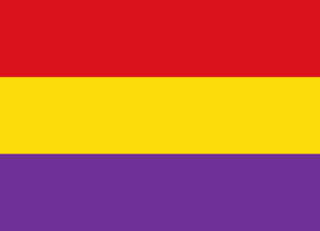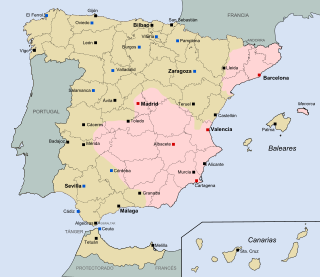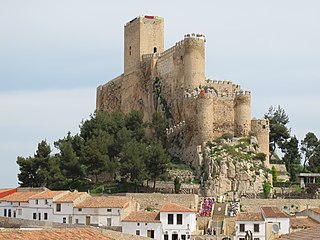
The First Mixed Brigade, also known as Brigada Lister, was a mixed brigade of the Spanish Republican Army in the Spanish Civil War. It was disbanded on 9 February 1939.

The Second Mixed Brigade, was a mixed brigade of the Spanish Republican Army in the Spanish Civil War. It was formed in October 1936 as a result of the reorganization of the Spanish Republican Armed forces.

The 223rd Mixed Brigade, was a mixed brigade of the Spanish Republican Army in the Spanish Civil War. It was formed in the summer of 1937 from Coastal Defence units and had four battalions, the 889, 890, 891 and 892. This unit lasted until the end of the war.

The 221st Mixed Brigade, was a Mixed Brigade of the Spanish Republican Army in the Spanish Civil War. It was formed in the summer of 1937 in Ciudad Real with four battalions, the 881, 882, 883 and 884.

The 224th Mixed Brigade was a mixed brigade of the Spanish Republican Army in the Spanish Civil War. It was formed in summer 1937 in Catalonia from scattered Coastal Defence units and had four battalions: the 893, 894, 895 and 896.

The 225th Mixed Brigade, was a mixed brigade of the Spanish Republican Army in the Spanish Civil War. It was formed in the summer of 1937 in Valencia with units belonging to the Eastern Coastal Defence and had four battalions, the 897, 898, 899 and 900.

The 26th Division was a division of the Spanish Republican Army in the Spanish Civil War. It was formed in April 1937 in Aragon from the militarized Columna Durruti during the reorganization of the Spanish Republican Armed Forces.

The 222nd Mixed Brigade, was a mixed brigade of the Spanish Republican Army in the Spanish Civil War. It was formed in the summer of 1937 with battalions of the Carabineros corps. Its only commander was the Carabineros Lieutenant Tiburcio Díaz Carrasco.

The 228th Mixed Brigade, was a short-lived mixed brigade of the Spanish Republican Army in the Spanish Civil War. It was formed in the last months of the Civil War with battalions belonging to the Carabineros corps. Its first and only leader was the Carabineros Commander Miguel Bascuñana Sánchez.

The 3rd Mixed Brigade, was one of the earliest mixed brigades of the Spanish Republican Army in the Spanish Civil War. It was formed in the fall of 1936 with battalions of the Carabineros corps and saw major action right away in the Defence of Madrid. This brigade also included female combatants —such as Sergeant "La Chata"— and would take part in most of the major battles of the Spanish Civil War, except in the Battle of Jarama.

The 109th Mixed Brigade, was a mixed brigade of the Spanish Republican Army in the Spanish Civil War. It was formed in the spring of 1937 in Utiel with four battalions, the 433, 434, 435 and 436.

The 182nd Mixed Brigade, was a mixed brigade of the Spanish Republican Army in the Spanish Civil War. It was formed in the spring of 1938 in Andalusia and had four battalions, the 725, 726, 727 and 728.

The 77th Division was a division of the Spanish Republican Army in the Spanish Civil War. It would be the last division of the loyalist forces to be formed.

The 175th Mixed Brigade, was a mixed brigade of the Spanish Republican Army in the Spanish Civil War. Its number was formerly corresponding to the 10th Santander Brigade, a unit operating in Santander, Spain but was assigned to a new unit in the spring of 1938 in Valencia Province and had four battalions, 697, 698, 699 and 700.

The 87th Mixed Brigade, was a mixed brigade of the Spanish Republican Army in the Spanish Civil War. It was formed in March 1937 with battalions of the Carabineros corps. Its first commander was Infantry Colonel Carlos Amores Cantos, who was succeeded by Militia Major Andrés Nieto Carmona.

The 8th Mixed Brigade was a mixed brigade of the Spanish Republican Army in the Spanish Civil War. It was formed at the beginning of the Defence of Madrid in early spring 1937 with battalions of the Carabineros corps and it remained in Madrid all along the war. Its first commander was Carabineros Lt. Colonel Enrique del Castillo Bravo who was succeeded by Carabineros Commanders Emeterio Jarillo Orgaz and José Casted Sena.

The 181st Mixed Brigade, was a mixed brigade of the Spanish Republican Army in the Spanish Civil War.

The 66th Mixed Brigade was a unit of the Popular Army of the Republic that participated in the Spanish Civil War. Born in the context of the Battle of Madrid, took part in the Battle of Jarama and the fronts of Guadalajara and Extremadura.(Spanish: 42.ª División) was a division of the Spanish Republican Army in the Spanish Civil War. This unit was involved in the Battle of Jarama —part of the Battle of Madrid, as well as in the Battle of Peñarroya, suffering grievous losses in both battles.

The 17th Mixed Brigade was a unit of the Popular Army of the Republic that participated in the Spanish Civil War. Born in the context of the Battle of Madrid, took part in the Battle of Jarama and the fronts of Guadalajara.(Spanish: 15.ª División) was a division of the Spanish Republican Army in the Spanish Civil War. This unit was involved in the Battle of Jarama —and great part of the Battle of Madrid, suffering grievous losses in both battles.



















